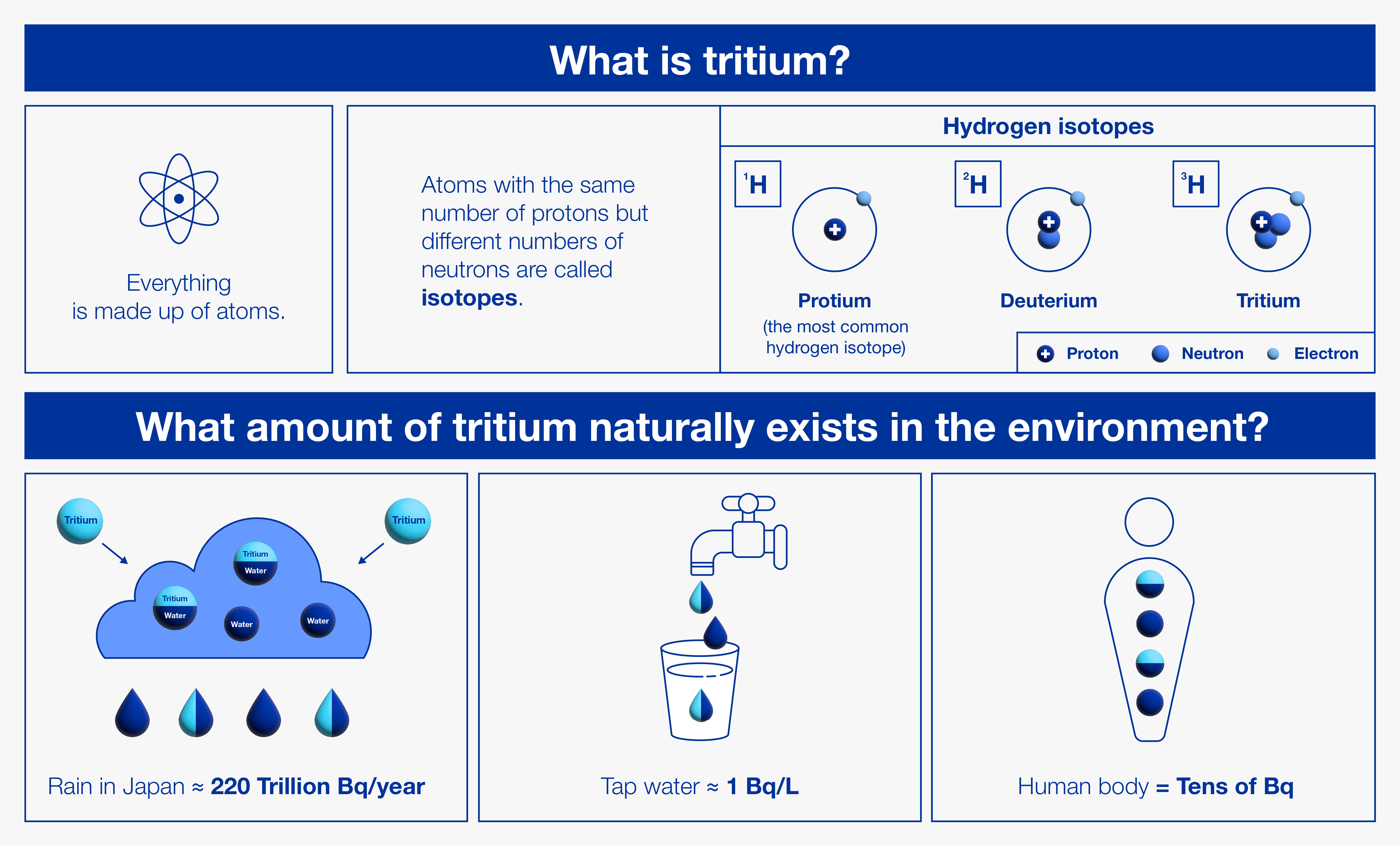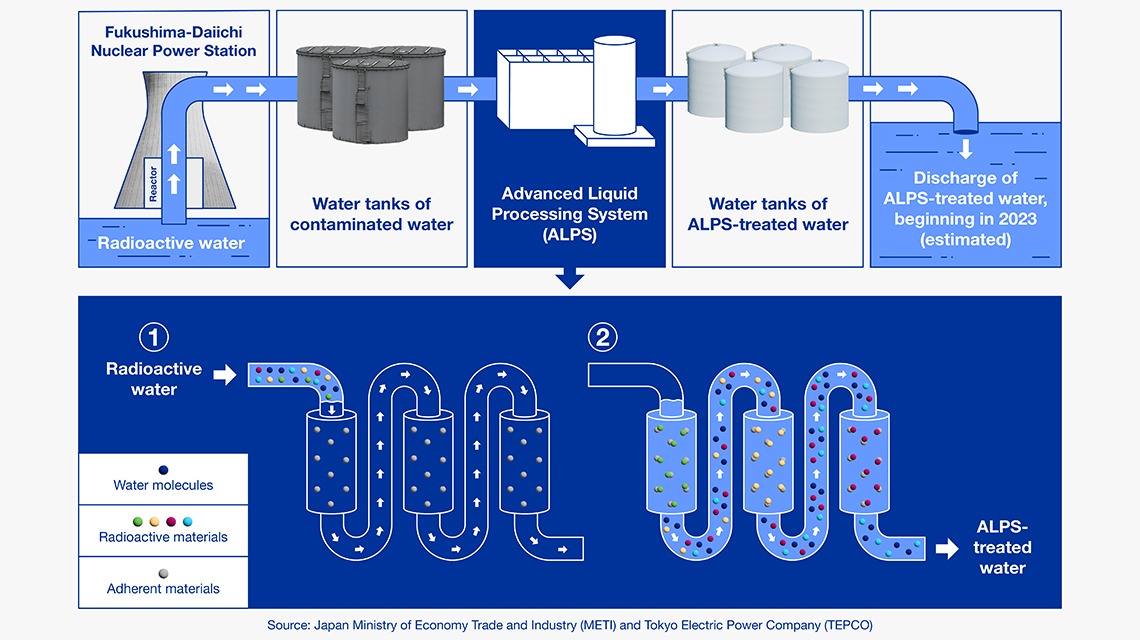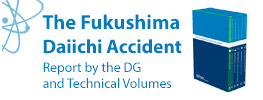Fukushima Daiichi ALPS Treated Water Discharge - FAQs
Advanced Liquid Processing System (ALPS)
Frequently asked questions
Where does the water stored at the Fukushima Daiichi Nuclear Power Station (NPS) come from?
Since the accident in March 2011, water is needed to continually cool the melted fuel and fuel debris at the Fukushima Daiichi NPS. In addition to the water pumped in for this purpose, groundwater also seeps into the site from the surrounding environment, and rainwater falls into the damaged reactor and turbine buildings. When water comes into contact with melted fuel, fuel debris and other radioactive substances, it becomes contaminated.
The contaminated water is then treated through a filtration process known as Advanced Liquid Processing System (ALPS) to remove most of the radioactivity before being stored.
What is Advanced Liquid Processing System (ALPS)?
What is tritium?

Tritium is a naturally occurring radioactive form of hydrogen that is produced in the atmosphere when cosmic rays collide with air molecules and has the lowest radiological impact of all naturally occurring radionuclides in seawater. Tritium is also a by-product of operating nuclear power plants to produce electricity.
Tritium has a radioactive half-life of 12.32 years. This means that for any given amount of tritium, only half will remain after 12.32 years due to radioactive decay.
Tritiated water has a relatively short biological half-life in the human body of 7 to 14 days. The biological half-life of a chemical (e.g., a drug) in a living organism is the time it takes for half of that chemical to be depleted or eliminated from the body.
Tritium emits weak beta-particles, i.e., electrons, with an average energy of 5.7 keV (kiloelectron-volts), which can penetrate about 6.0 mm of air but cannot penetrate the body through human skin. It may present a radiation hazard if inhaled or ingested but is only harmful to humans in very large doses.
Why isn’t tritium removed during treatment?
It is technically very difficult to remove tritiated water from water. Tritium is an isotope of hydrogen, and water containing tritium has chemical features almost identical to water with ordinary hydrogen.
Technologies exist that can recover tritium when it is highly concentrated in small amounts of water, for example at nuclear fusion facilities. However, the stored water at the Fukushima Daiichi NPS has a low concentration of tritium in a large volume of water and so the existing technologies are not applicable.
How will the ALPS-treated water containing tritium be managed at Fukushima Daiichi?
Currently, contaminated water produced at the Fukushima Daiichi NPS is treated and stored on site in specially prepared tanks. TEPCO, the plant operator, has installed roughly 1000 of these tanks at the Fukushima Daiichi NPS site to hold around 1.3 million cubic meters of the treated water (as of 2 June 2022). Since 2011, the volume of water in storage has increased steadily, and the current tank space available to store this water is nearing full capacity.
While improvements have been made to significantly reduce the rate at which contaminated water is produced, TEPCO has determined a long-term disposal solution is needed to help ensure the continued decommissioning of the site. In April 2021, the Government of Japan issued its Basic Policy outlining a direction to dispose of ALPS-treated water through controlled discharges into the sea to be started in approximately 2 years, subject to domestic regulatory approval.
Do other plants discharge water containing tritium?
Most nuclear power plants around the world routinely and safely release treated water, containing low level concentrations of tritium and other radionuclides to the environment as part of normal operations.
Water is used in nuclear power plants to transfer heat from the reactor core to the steam turbines and in cooling systems developed to reduce surplus heat. Water requirements for nuclear power plants vary depending on the cooling system used, the thermal efficiency of the nuclear power plant, the requirements for service water, safety features and waste disposal techniques.The regular practice in nuclear installations is the authorized and controlled discharge of tritiated water into nearby water bodies, such as rivers, lakes or coastal areas. Water discharges at nuclear power plants are authorized releases and are closely monitored by the operators and regulators to ensure safety. The IAEA Safety Standards include guidance on the authorization of discharges to the environment.
How specifically will the IAEA review and monitor the water release?
Japan has requested the IAEA to conduct a review of safety-related aspects of handling the ALPS-treated water. The Task Force will review the discharge plans and associated activities of the Government of Japan and TEPCO against IAEA Safety Standards and will conduct independent source and environmental monitoring to corroborate the data published by the Government of Japan and TEPCO. The goal is to ensure the water disposal is carried out in compliance with the IAEA Safety Standards and, as such, without an adverse impact on human health and the environment. This review will also help build public confidence.
The different technical components of the review will include analysing TEPCO’s implementation plan and radiological environmental impact assessment and other relevant documents for safety; assessing regulatory activities and processes (e.g., authorization for the discharge, inspections, etc.) related to the proposed discharges of ALPS-treated water; conducting review missions at the Fukushima Daiichi NPS to collect factual information, resolve questions and to observe activities relevant to the ALPS process; and performing sampling and analysis to corroborate existing data.
These activities began in 2021 and will continue for many years, consistent with the IAEA Director General’s commitment to provide support before, during and after the water discharge. The majority of the IAEA’s review is planned to be completed prior to the discharge of water by TEPCO in 2023 (estimated), subject to domestic regulatory approval; however, ongoing monitoring and review activities will continue for many years.
In order to implement the IAEA’s review in a fully transparent and inclusive manner, the IAEA Director General, Rafael Mariano Grossi, has established a Task Force.
Who is included in the Task Force?
The Task Force was established under the authority of the IAEA Secretariat and is chaired by a senior IAEA official. IAEA staff members in the Task Force will serve as the primary source for the technical and regulatory expertise needed to complete the IAEA’s review.
The Task Force also includes 11 internationally recognized experts with extensive experience from a wide range of technical specialties, from Argentina, Australia, Canada, China, France, the Marshall Islands, the Republic of Korea, the Russian Federation, the United Kingdom, the United States and Viet Nam. These experts will support the review and serve on the Task Force in their individual professional capacity to help ensure the IAEA’s review is comprehensive, benefits from the best international expertise and includes a diverse range of technical viewpoints.
What technical aspects will the Task Force focus on?
The IAEA’s review of the discharge of the ALPS-treated water will focus specifically on safety-related aspects of Japan’s discharge plan. This work will include reviewing:
- The radiological characterization of the ALPS-treated water to be discharged.
- The safety related aspects of the water discharge process, including the equipment to be used and the criterion to be applied and observed.
- The assessment of the radiological environmental impact related to ensuring the protection of people and environment.
- The environmental monitoring associated with the discharge.
- • The regulatory control, including authorization, inspection and ongoing assessment of the discharge plan.
Additionally, the IAEA will conduct independent source and environmental monitoring to corroborate the data published by the Government of Japan. This work will be done in collaboration with IAEA and third-party laboratories.
The Task Force will conduct an objective technical review in a transparent manner consistent with the IAEA Safety Standards.
How will the IAEA report on the findings of the Task Force?
The IAEA’s review will extend over several years, and progress will be reported in different ways depending on the project status and the interested parties involved.
Reports of relevant review missions will be used to document relevant findings from the Task Force and will be released approximately eight weeks after each review mission. These reports will be made publicly available on the IAEA website. Prior to the discharge of the ALPS-treated water beginning in 2023 (estimated), subject to domestic regulatory approval, the IAEA will issue a full report containing the collected conclusions of the Task Force across all aspects of the IAEA’s review.
Additionally, the IAEA will communicate with the public and Member States’ governments through presentations and briefings in an ad hoc manner to ensure the timely dissemination of important information.
This set of questions and answers will also be updated as the IAEA’s review continues.
Will the findings of the IAEA review be legally binding to the Japanese authorities?
The results and conclusions of the IAEA’s review are not legally binding on the Government of Japan but will be helpful in informing the international community and supporting an overall goal of enhancing transparency. The IAEA’s review will be conducted using the IAEA Safety Standards and will assess the implementation of the Government of Japan’s Basic Policy for handling ALPS-treated water at the Fukushima Daiichi NPS against those standards. The IAEA Safety Standards, which are developed in consultation with all IAEA Member States, reflect an international consensus on what constitutes a high level of safety for protecting people and the environment from harmful effects of ionizing radiation.
Generally, the IAEA Safety Standards are not legally binding for Member States, however, they are widely used by Member States on a voluntary basis as a reference for their national regulations. The Government of Japan remains fully responsible for the safety of handling ALPS-treated water and for any ensuing decisions and actions deemed necessary to meet this objective.
Has the IAEA already started its review?
IAEA officials visited Japan in September 2021 to officially launch the multi-year review of the planned ALPS-treated water discharge and to agree on the general timeline of activities. Subsequently, there have been multiple on-site visits to Japan and Task Force meetings to progress with the review. The IAEA will continue implementing activities throughout 2022 and beyond. As noted by the IAEA Director General, the IAEA’s review will continue before, during and after the water discharge.
Is the IAEA also coordinating with other countries in the region?
As the project moves forward, the Agency will be reporting regularly to keep the public and Member States’ governments apprised of its progress throughout the project. Transparency is a key component of this review, and the IAEA will use all possible opportunities to communicate the status and key conclusions from its review to interested parties.




